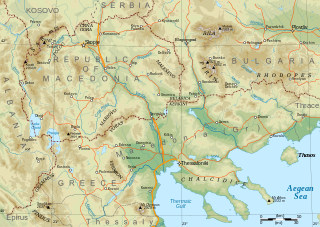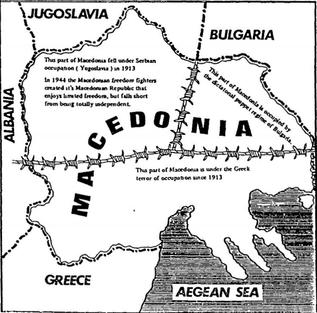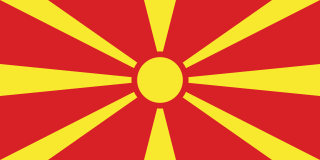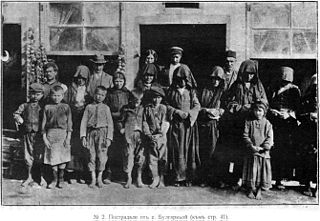
Macedonia is a geographical and historical region of the Balkan Peninsula in Southeast Europe. Its boundaries have changed considerably over time; however, it came to be defined as the modern geographical region by the mid-19th century. Today the region is considered to include parts of six Balkan countries: all of North Macedonia, large parts of Greece and Bulgaria, and smaller parts of Albania, Serbia, and Kosovo. It covers approximately 67,000 square kilometres (25,869 sq mi) and has a population of around five million. Greek Macedonia comprises about half of Macedonia's area and population.

Demographic features of the population of North Macedonia include population density, ethnicity, education level, health of the populace, economic status, religious affiliations and other aspects of the population.

The demography of the Republic of Bulgaria is monitored by the National Statistical Institute of Bulgaria. Demographic features of the population of Bulgaria include population density, ethnicity, education level, health of the populace, economic status, religious affiliations and others.

The region of Macedonia is known to have been inhabited since Paleolithic times.

Western Thrace or Aegean Thrace, also known as Greek Thrace, is a geographic and historical region of Greece, between the Nestos and Evros rivers in the northeast of the country; East Thrace, which lies east of the river Evros, forms the European part of Turkey, and the area to the north, in Bulgaria, is known as Northern Thrace.
After the Russo-Turkish War of 1877–1878, the 1878 Treaty of Berlin set up an autonomous state, the Principality of Bulgaria, within the Ottoman Empire. Although remaining under Ottoman sovereignty, it functioned independently, taking Alexander of Battenberg as its first prince in 1879. In 1885 Alexander took control of the still-Ottoman Eastern Rumelia, officially under a personal union. Following Prince Alexander's abdication (1886), a Bulgarian Assembly elected Ferdinand I as prince in 1887. Full independence from Ottoman control was declared in 1908.

Bulgarian Turks are ethnic Turks from Bulgaria. According to the 2021 census, there were 508,375 Bulgarians of Turkish descent, roughly 8.4% of the population, making them the country's largest ethnic minority. Bulgarian Turks also comprise the largest single population of Turks in the Balkans. They primarily live in the southern province of Kardzhali and the northeastern provinces of Shumen, Silistra, Razgrad and Targovishte. There is also a diaspora outside Bulgaria in countries such as Turkey, Austria, the Netherlands, Sweden, Norway and Romania, the most significant of which are the Bulgarian Turks in Turkey.

The Tsardom of Bulgaria, also referred to as the Third Bulgarian Tsardom, sometimes translated in English as the "Kingdom of Bulgaria", or simply Bulgaria, was a constitutional monarchy in Southeastern Europe, which was established on 5 October 1908, when the Bulgarian state was raised from a principality to a tsardom.

The history of Bulgaria during World War II encompasses an initial period of neutrality until 1 March 1941, a period of alliance with the Axis Powers until 8 September 1944, and a period of alignment with the Allies in the final year of the war. Bulgarian military forces occupied with German consent parts of the Kingdoms of Greece and Yugoslavia which Bulgarian irredentism claimed on the basis of the 1878 Treaty of San Stefano. Bulgaria resisted Axis pressure to join the war against the Soviet Union, which began on 22 June 1941, but did declare war on Britain and the United States on 13 December 1941. The Red Army entered Bulgaria on 8 September 1944; Bulgaria declared war on Germany the next day.

Bulgarian irredentism is a term to identify the territory associated with a historical national state and a modern Bulgarian irredentist nationalist movement in the 19th and 20th centuries, which would include most of Macedonia, Thrace and Moesia.

In the 19th century, the national revival in the Balkans began; national and religious antagonism flared, and conflict was heightened by the Ottoman policy of playing one group against the other. Meanwhile, the Ottoman Empire lost control over the major sections of Greece, Serbia, and Bulgaria, each of which claimed Macedonia on historical or ethnical grounds.

United Macedonia, or Greater Macedonia, is an irredentist concept among Macedonian nationalists that aims to unify the transnational region of Macedonia in Southeastern Europe into a single state that would be dominated by ethnic Macedonians. The proposed capital of such a United Macedonia is the city of Thessaloniki, the capital of Greek Macedonia, which ethnic Macedonians and the Yugoslav leader Josip Broz Tito had planned to incorporate into their own states.

Turks of Western Thrace are ethnic Turks who live in Western Thrace, in the province of East Macedonia and Thrace in Northern Greece.

Andon Kalchev was a Bulgarian army officer, one of the leaders of the Bulgarian-backed Ohrana, a paramilitary formation of Bulgarians in Greek Macedonia during World War II Axis occupation. He was active outside the Bulgarian occupied area of Macedonia, under the tolerance of the Italian and German authorities which used him in their fights with rival Greek EAM-ELAS and Yugoslav Communist resistance groups. Because of his collaborationist activity, he was sentenced to death by Greek military tribunal, and was executed by firing squad on 27 August 1948.

The history of Macedonians has been shaped by population shifts and political developments in the southern Balkans, especially within the region of Macedonia. The ideas of separate Macedonian identity grew in significance after the First World War, both in Vardar and among the left-leaning diaspora in Bulgaria, and were endorsed by the Comintern. During the Second World War, these ideas were supported by the Communist Partisans, but the decisive point in the ethnogenesis of these South Slavic people was the creation of the Socialist Republic of Macedonia after World War II, as a new state in the framework of the Socialist Federal Republic of Yugoslavia.

Ethnic Macedonians in Bulgaria are a group in Bulgaria concentrated within Blagoevgrad Province and the capital Sofia. Per 2021 Bulgarian census they are 1,143 people but are not recognised as an ethnic minority.
Slavic speakers are a minority population in the northern Greek region of Macedonia, who are mostly concentrated in certain parts of the peripheries of West and Central Macedonia, adjacent to the territory of the state of North Macedonia. Their dialects are called today "Slavic" in Greece, while generally they are considered Macedonian. Some members have formed their own emigrant communities in neighbouring countries, as well as further abroad.

Thracians or Thracian Bulgarians are a regional, ethnographic group of ethnic Bulgarians, inhabiting or native to Thrace. Today, the larger part of this population is concentrated in Northern Thrace, but much is spread across the whole of Bulgaria and the diaspora.

The Turks in Europe refers to Turkic peoples living in Europe, particularly those of Turkish origin.

Bulgarian Millet was an ethno-religious and linguistic community within the Ottoman Empire from the mid-19th to early 20th century.



























